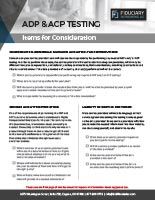
The Story
CET Metals has a 401(k) plan through a national payroll provider. As part of the payroll provider’s service package, they provide a website that generates the ADP and ACP testing each year. Mina at CET Metals, must go on line each year, code in ownership data and generate her own testing results.
In 2011, Mina ran the plan’s ADP and ACP testing and received a report that said the plan failed the testing. The owner of CET Metals, Scott, was distressed as it meant he would receive the majority of his 401(k) deferrals and matching contributions back. He reached out to the retirement staff at the payroll provider and was told that they didn’t provide assistance on the testing. They suggested he reach out to an ERISA attorney for assistance. Scott reached out to a local ERISA attorney who referred him to an expert in plan testing and correction. Scott retained the testing expert.
How did they fix it?
After reviewing the setup of the payroll system, it was determined that Scott’s family was not being considered as highly compensated employees. The system was simply not coded correctly. Mina didn’t have the expertise to understand the testing to realize it was wrong. Once the system was properly coded, the plan actually passed the ADP and ACP tests. While the cost to CET Metals was about $500 for the testing expert’s time, Scott was able to keep all of his $24,000 of deferrals and $12,000 of match in the plan based on the passing test. Scott decided to bring the testing consultant back each year in the future to review the system after Mina coded everything to ensure his testing was accurate and that he’d get the maximum benefit from the plan.
How did they avoid doing it again?
Scott recognized that Mina was not sufficiently educated on the company’s 401(k) plan and the related rules and regulations to properly code the payroll system to ensure correct testing results were achieved. Scott worried that other errors might be occurring that hadn’t been brought to his attention. Scott reached out to Fiduciary Outsourcing. He decided to retain us to provide fiduciary oversight of his payroll system to ensure the 401(k) plan was administered properly.

The Mistake
Each year non-safe harbor 401(k) plans must satisfy an Average Deferral Percentage (”ADP”) test. If they provide matching contributions, they must also satisfy an Average Contribution Percentage (“ACP”) test. If either or both tests fail, the failed tests must be corrected.
The ADP test looks at the average savings rate of eligible highly paid employees and owners. It compares their average savings rate to all other employees. The highly paid employees and owners cannot save too much more, on average, than the lower paid employees. Doesn’t sound too hard, right?
First of all, the correct deferrals must be used in the test. Does that mean the amount taken out of employees checks? What if a different amount was deposited to the plan, for example somehow one deposit never got made during the year? Next, the correct compensation must be used in the test. There are many possible definitions of compensation, so the plan document must be consulted to determine which definition is used to perform the ADP test. Then, those employees who are considered highly compensated (the highly paid employees and owners) must be determined. Did you know that stock ownership is sometimes attributed to family members even if the family member doesn’t directly own any stock? Lastly, the determination of who was eligible for the plan at any time during the year, and therefore must be included in the test, must be done.
The same rules apply to the ACP testing substituting matching contributions for deferrals.
Once the testing is completed, it will either pass or fail. If it fails, that means the highly compensated employees saved or received matching that was substantially more on average than everyone else.
To fix the test, either:
- the plan sponsor must contribute more money to the non-highly compensated employees to increase their average; or
- the amounts saved or matched to the highly compensated employees must be taken away from the highly compensated employees to lower their average.
Deferrals that are taken away from highly compensated employees are returned to them. Matching money taken away from highly compensated employees is distributed to them if they are vested or forfeited if they are not. And, the amounts returned may need to be adjusted for earnings.
These rules are very complex. It is not uncommon in this age of technology for plan sponsors to be given a website and told to generate their own ADP or ACP testing results based on what was actually deposited to the plan. No one asks if any deferrals or match are missing. No one confirms the compensation used in the test matches what the plan document says must be used. No one checks the highly compensated employee determination. Etc. Then, on audit, the IRS agent determines the test was done improperly. Are we really surprised?

What Happens
If the plan fails to perform the ADP or ACP test properly, the first step to correct this mistake is to have the test run properly. Imagine that the plan was tested for 2014 and passed. In early 2016, it was determined that the compensation used in the 2014 testing was wrong. The plan is rerun using the correct definition of compensation and it still passed. Since no money was returned to participants and no additional contributions were made to correct a failed test, the plan has no problems. The proper test would be stored in the plan’s files and the issue is resolved.
Now let’s look at the same scenario, except in this case when the testing is rerun with the correct compensation it fails. The IRS requires that any corrective distributions be made within 2 ½ months of the end of the plan year for which the failure occurs or they impose a 10% excise tax. If the plan has an automatic enrollment provision, the 2 ½ months becomes 6 months in order to avoid the 10% excise tax. If you miss the 2 ½ or 6 month deadline, you can still make the distributions through the end of the current plan year to fix the prior year’s test. You just have to pay the excise taxes. If you intend to fix the failure by making additional contributions, then you also have until the end of the current plan year to fix the prior year’s test.
Using the correction principals from IRS Revenue Procedure 2013-12, you can self-correct the testing failure for another 2 years. However, the IRS changes the correction method you must use. Once you get into the 2-year self-correction period, you must return the needed funds to the highly compensated employees and also make a contribution for the amount returned to the non-highly compensated employees.
If you fail to fix the test for 3 years and you subsequently find the error, you must then correct by filing the plan with the IRS through their Voluntary Correction Program.
The last scenario is that the testing done with the wrong compensation failed. You either returned money to the highly compensated employees or contributed money for the non-highly compensated employees. However, when the test is rerun with the correct compensation, you discover you returned too much or too little or perhaps contributed too much or too little. At this point, things get much more complicated as you may have over or underpaid terminated participants. You may have allowed loans for amounts in excess of what would otherwise have been available.
In any of these scenarios, you should obtain the help of a service provider with expertise in correcting plan errors who can walk you through the IRS rules that apply to your specific situation.
Avoid it
First, determine which service provider is performing the ADP or ACP testing for you. Ask that service provider identify exactly which data they need to perform the testing for you plan. Confirm with your payroll department that all of the necessary information is being provided each year. Someone in your firm may want to verify the data prior to submitting it to the service provider.
If you use a service provider who asks you to upload the data and run the testing yourself, consider hiring a consultant to assist you. The consultant can review the data to be uploaded and ensure the test results produced look correct.
In the event a test fails, take the necessary steps to identify when the correction must be made and then ensure it gets made.

How We Help
You have the ability to outsource your responsibilities as the Plan Administrator. As such, you can outsource the responsibility for ensuring the nondiscrimination testing is done properly. You can also outsource to use the ability to audit the payroll system to ensure correct data is generated or to audit the reports produced by the payroll system prior to testing being performed. We then assume a fiduciary responsibility with regard to the plan’s nondiscrimination testing.

The Story
CET Metals has a 401(k) plan through a national payroll provider. As part of the payroll provider’s service package, they provide a website that generates the ADP and ACP testing each year. Mina at CET Metals, must go on line each year, code in ownership data and generate her own testing results.
In 2011, Mina ran the plan’s ADP and ACP testing and received a report that said the plan failed the testing. The owner of CET Metals, Scott, was distressed as it meant he would receive the majority of his 401(k) deferrals and matching contributions back. He reached out to the retirement staff at the payroll provider and was told that they didn’t provide assistance on the testing. They suggested he reach out to an ERISA attorney for assistance. Scott reached out to a local ERISA attorney who referred him to an expert in plan testing and correction. Scott retained the testing expert.
How did they fix it?
After reviewing the setup of the payroll system, it was determined that Scott’s family was not being considered as highly compensated employees. The system was simply not coded correctly. Mina didn’t have the expertise to understand the testing to realize it was wrong. Once the system was properly coded, the plan actually passed the ADP and ACP tests. While the cost to CET Metals was about $500 for the testing expert’s time, Scott was able to keep all of his $24,000 of deferrals and $12,000 of match in the plan based on the passing test. Scott decided to bring the testing consultant back each year in the future to review the system after Mina coded everything to ensure his testing was accurate and that he’d get the maximum benefit from the plan.
How did they avoid doing it again?
Scott recognized that Mina was not sufficiently educated on the company’s 401(k) plan and the related rules and regulations to properly code the payroll system to ensure correct testing results were achieved. Scott worried that other errors might be occurring that hadn’t been brought to his attention. Scott reached out to Fiduciary Outsourcing. He decided to retain us to provide fiduciary oversight of his payroll system to ensure the 401(k) plan was administered properly.

Each year non-safe harbor 401(k) plans must satisfy an Average Deferral Percentage (”ADP”) test. If they provide matching contributions, they must also satisfy an Average Contribution Percentage (“ACP”) test. If either or both tests fail, the failed tests must be corrected.
The ADP test looks at the average savings rate of eligible highly paid employees and owners. It compares their average savings rate to all other employees. The highly paid employees and owners cannot save too much more, on average, than the lower paid employees. Doesn’t sound too hard, right?
First of all, the correct deferrals must be used in the test. Does that mean the amount taken out of employees checks? What if a different amount was deposited to the plan, for example somehow one deposit never got made during the year? Next, the correct compensation must be used in the test. There are many possible definitions of compensation, so the plan document must be consulted to determine which definition is used to perform the ADP test. Then, those employees who are considered highly compensated (the highly paid employees and owners) must be determined. Did you know that stock ownership is sometimes attributed to family members even if the family member doesn’t directly own any stock? Lastly, the determination of who was eligible for the plan at any time during the year, and therefore must be included in the test, must be done.
The same rules apply to the ACP testing substituting matching contributions for deferrals.
Once the testing is completed, it will either pass or fail. If it fails, that means the highly compensated employees saved or received matching that was substantially more on average than everyone else.
To fix the test, either:
- the plan sponsor must contribute more money to the non-highly compensated employees to increase their average; or
- the amounts saved or matched to the highly compensated employees must be taken away from the highly compensated employees to lower their average.
Deferrals that are taken away from highly compensated employees are returned to them. Matching money taken away from highly compensated employees is distributed to them if they are vested or forfeited if they are not. And, the amounts returned may need to be adjusted for earnings.
These rules are very complex. It is not uncommon in this age of technology for plan sponsors to be given a website and told to generate their own ADP or ACP testing results based on what was actually deposited to the plan. No one asks if any deferrals or match are missing. No one confirms the compensation used in the test matches what the plan document says must be used. No one checks the highly compensated employee determination. Etc. Then, on audit, the IRS agent determines the test was done improperly. Are we really surprised?

What Happens
If the plan fails to perform the ADP or ACP test properly, the first step to correct this mistake is to have the test run properly. Imagine that the plan was tested for 2014 and passed. In early 2016, it was determined that the compensation used in the 2014 testing was wrong. The plan is rerun using the correct definition of compensation and it still passed. Since no money was returned to participants and no additional contributions were made to correct a failed test, the plan has no problems. The proper test would be stored in the plan’s files and the issue is resolved.
Now let’s look at the same scenario, except in this case when the testing is rerun with the correct compensation it fails. The IRS requires that any corrective distributions be made within 2 ½ months of the end of the plan year for which the failure occurs or they impose a 10% excise tax. If the plan has an automatic enrollment provision, the 2 ½ months becomes 6 months in order to avoid the 10% excise tax. If you miss the 2 ½ or 6 month deadline, you can still make the distributions through the end of the current plan year to fix the prior year’s test. You just have to pay the excise taxes. If you intend to fix the failure by making additional contributions, then you also have until the end of the current plan year to fix the prior year’s test.
Using the correction principals from IRS Revenue Procedure 2013-12, you can self-correct the testing failure for another 2 years. However, the IRS changes the correction method you must use. Once you get into the 2-year self-correction period, you must return the needed funds to the highly compensated employees and also make a contribution for the amount returned to the non-highly compensated employees.
If you fail to fix the test for 3 years and you subsequently find the error, you must then correct by filing the plan with the IRS through their Voluntary Correction Program.
The last scenario is that the testing done with the wrong compensation failed. You either returned money to the highly compensated employees or contributed money for the non-highly compensated employees. However, when the test is rerun with the correct compensation, you discover you returned too much or too little or perhaps contributed too much or too little. At this point, things get much more complicated as you may have over or underpaid terminated participants. You may have allowed loans for amounts in excess of what would otherwise have been available.
In any of these scenarios, you should obtain the help of a service provider with expertise in correcting plan errors who can walk you through the IRS rules that apply to your specific situation.
Avoid it
First, determine which service provider is performing the ADP or ACP testing for you. Ask that service provider identify exactly which data they need to perform the testing for you plan. Confirm with your payroll department that all of the necessary information is being provided each year. Someone in your firm may want to verify the data prior to submitting it to the service provider.
If you use a service provider who asks you to upload the data and run the testing yourself, consider hiring a consultant to assist you. The consultant can review the data to be uploaded and ensure the test results produced look correct.
In the event a test fails, take the necessary steps to identify when the correction must be made and then ensure it gets made.

How We Help
You have the ability to outsource your responsibilities as the Plan Administrator. As such, you can outsource the responsibility for ensuring the nondiscrimination testing is done properly. You can also outsource to use the ability to audit the payroll system to ensure correct data is generated or to audit the reports produced by the payroll system prior to testing being performed. We then assume a fiduciary responsibility with regard to the plan’s nondiscrimination testing.


